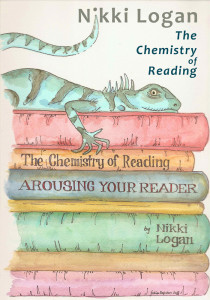The best $2.99 you’ll ever spend on your writing
 The brain is like Google. It ranks things by referrals. The most engaging books trigger a response in multiple parts of the brain and thereby get ranked more highly by it. And books that get highly ranked become ‘must buys’.
The brain is like Google. It ranks things by referrals. The most engaging books trigger a response in multiple parts of the brain and thereby get ranked more highly by it. And books that get highly ranked become ‘must buys’.
‘The Chemistry of Reading’ explores (in plain, digestible English) how the body reacts during the reading experience and how writers can harness that to create an unforgettable story that arouses multiple parts of the reader’s brain.
BUY IT NOW!
Smashwords | Kindle US | Kindle UK | Kobo/B&N
Publish Date: 8 May 2012
Excerpt
The Chemistry of Reading
Introduction
When I set out to develop a practical workshop on the importance of arousing readers, I planned a shortish examination of the different ways that readers can be aroused by fiction. The visceral arousal of a good thriller, the emotional arousal of romance, the intellectual arousal of a mystery/intrigue novel, the sensual arousal of erotic fiction, or the creative arousal of an interplanetary fantasy.
As I researched it, I realised that would be telling only one third of the story. Before I could look at the technical aspects of how to increase the arousal of your readers, I had to examine why you would want to. And before why, it was important that participants understood what they were trying to achieve.
And so Arousing your Reader became The Chemistry of Reading: Arousing your Reader.
It will become abundantly apparent very shortly that I’m not a scientist. I have a couple of years of high-school human biology behind me. So if I can understand this then anyone can. I searched and searched for information on the chemistry and biology of reading (specifically) and there wasn’t a lot out there. I read papers and trawled websites, pulled what I could together, chewed it all up and regurgitated it in what I hope is plain English. I’ve glossed over much of the hard science and just focussed on the most digestible bits.
So, the first thing this book is not is a scientific paper.
The second thing this book is not is a how-to on writing sex and sensuality in fiction. If you were looking for that, you’ve made a bad call. Arousal is about so much more than physical titillation.
The Chemistry of Reading: Arousing your Reader seeks to help you to understand how reading impacts on the human brain and how to make the most of that knowledge to enrich your writing.
Arousal and writers of commercial fiction
Writers of commercial fiction rely on repeat readership in order to build a following large enough to let them continue feeding their families. While commercial fiction is well-endowed with blockbusters compared to other kinds of fiction, stunning success of that kind is still a mythic rarity. It is said that 99% of fiction is never picked up by a traditional publisher, and of the 1% that is, less than 5% of those books ever bust out of the mid-list, let alone achieve blockbuster-status.
Authors of commercial fiction need to be prolific, consistent and visible in order to begin building a following, and if they want to hold it—and grow it—they need to produce books that engage and excite readers.
The key to engagement is arousal.
The Chemistry of Reading: Arousing your Reader addresses the what, why and how of this topic and is presented in four parts.
Part I: the science-y bit
The biology/chemistry of arousal and its purpose in the body.
Part II: the mercenary bi
Why you should be trying to trigger arousal in your reader.
Part III: the practical bit
A toolkit to turn your understanding of the science into tangible, useful skills that will make your stories impossible to ignore.
Part IV: the workshoppy bit
Exercises to test your understanding of the techniques used by other writers—and yourself—to arouse your reader.
New writers might be tempted to skip straight to the ‘toolkit’ at the end but you’d be missing all the good stuff before it. Hang in there, hold your breath and wade into the science.
More experienced writers should already be familiar with the tools in Part III but I bet you’ve never thought of them quite this way before. Or understood why they are so effective. I’m expecting you guys to ace Part IV.
You don’t need to be a scientist to understand this book, but I’ll be calling upon your natural writers’ curiosity and fascination with how things work in Part I. Neither do you need a business degree to negotiate the second part of the book—just a good sense for people. Parts III and IV will be more familiar to the authors out there: a craft toolkit and some workshop exercises to test out your new arouse-o-meter.
Along the way I’ll be throwing some pretty terrible analogies at you to keep things digestible and some science-for-dummies stuff (politely boxed up so that those with their geek-on can skip right over) to help explain the most complex or important elements.
Okay. Artistic sensibilities holstered? Mind open?
Let’s go….
BUY IT NOW: Smashwords | Kindle US | Kindle UK | Kobo/B&N
